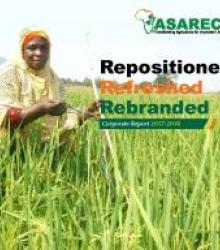| Title | Author | Asbract |
|---|---|---|
| Tanzania Fisheries Research Institute | ASARECA | The warning was sounded by TAFIRI researcher Mary Kishe in Dar es Salaam when speaking to The Guardian in an exclusive interview shortly after the just ended consultative workshop on Food Price Trend Analysis: Implication to Food Security in Tanzania, organized by Association of Strengthening Agriculture Research for Eastern and Central Africa (ASARECA). |
| Farmers speak of technology benefits | EAAPP - ASARECA | |
| Predictions warn of rapid MLN spread, spell doom in AFRICA | Brian Isabirye and Ivan Rwomushana | The Maize Lethal Necrosis (MLN) disease is so dangerous that we cannot wait for its next victims incognito. These are direct words of Dr. Brian Isabirye, the ASARECA official in charge of coordinating regional efforts to curb the spread of MLN in Eastern and Central Africa. MLN was first spotted in Kenya in 2011, before spreading to Uganda, Ethiopia, Tanzania and Rwanda. We are not very certain of where it will attack next, says Dr. Isabirye. As the saying goes, fore warned is fore armed predictive study to predetermine potential areas of risk of infestation by MLN was undertaken by ASARECA in partnership with colleagues in the region. The study attempts to understand the spatio-temporal distribution of MLN risk in Africa using ecological niche models, which include inputs such as climatic data (temperature and rainfall) and known detections of MLN across Africa. Outcomes of the modeling published in the Journal of Crop Protection indicates that a high risk of MLN across the warm arid, semi arid, and sub-humid tropics of Eastern and Southern Africa. Western and Southern Africa showed only moderate suitability, while much of North Africa appears to be marginal in risk. The countries with largest modeled suitable habitats for MCMV virus were Ethiopia, Tanzania, D.R. Congo, Angola, South Africa and Madagascar. In terms of proportional potential yield loss, Rwanda, Burundi, and Swaziland are likely to be worst hit with 100% yield loses, followed by Uganda (88.1%), Tanzania (65.9%), Ethiopia (59.8%), Malawi (53.8%), Madagascar (45.1%), and Kenya (41.1%). See full article pdf and link http://jcp.modares.ac.ir/article_14054_5288be780a04c484c434e32a2667e31b.pdf |
| Farmer awareness key as maize comes under attack | Frank Kagoda, Robert Gidoi and Brian Isabirye | It is now scientifically double-checked. In Uganda, the Maize Lethal Necrosis Virus (MLN) is prevalent in most farmers fields in the districts of Tororo, Mbale, Sironko and Busia. According to survey findings published in the African Journal of Agricultural Research, the disease can attack at any stage of crop growth, two weeks after planting leading to average yield losses of up to 50.5% or US$ 332 per hectare. First reported in Uganda in 2013, information about the prevalence, yield loss, mitigation measures and socio-economic effects of MLN is still scanty. Survey findings of a study conducted by NARO and ASARECA involving 300 respondents in seven districts of Eastern Uganda on the status of the disease, recommends intensification of MLN sensitization to inform farmers on management practices such as crop rotation, good sanitation practices, and use of chemical sprays to control MLN. The study, however, indicates that expediting the breeding process for the development of MLN resistant or tolerant varieties is the most viable option to bring a lasting solution to the disease. |
| Simple tools, huge impact: How the Virtual Irrigation Academy is changing livelihood in Malawi | Ben Moses Ilakut, Moses Odeke, Dr. Isaac Fandika, Geoffrey Mwepa and Jonathan Chikankheni | Simple tools, huge impact: How the Virtual Irrigation Academy is changing livelihood in Malawi |
| Irrigation revolution: Delivering high yields under harsh climatic conditions in Tanzania | ASARECA | Irrigation revolution: Delivering high yields under harsh climatic conditions in Tanzania |
Search
Impact Stories
Copyright © 2025. All rights reserved.
Designed By ASARECA


